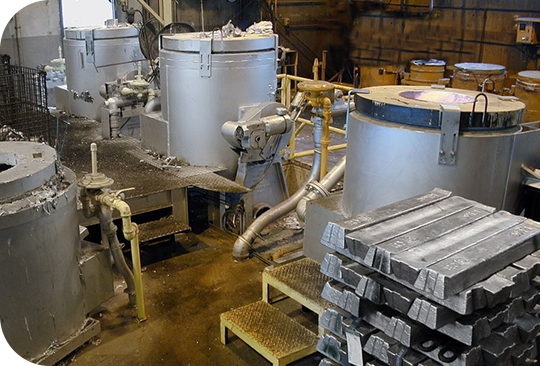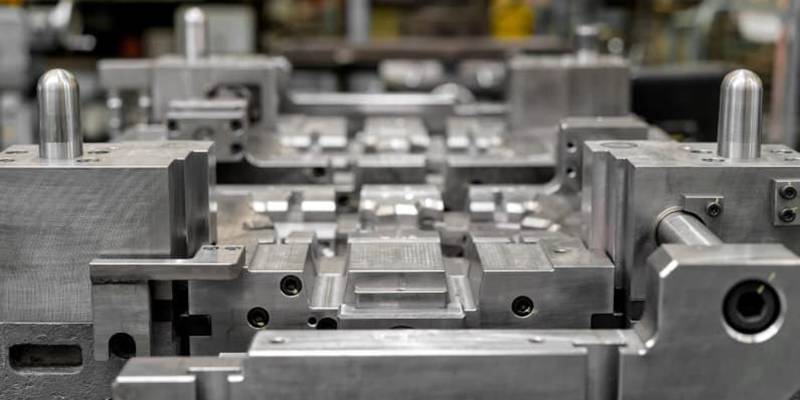The value of Aluminum Casting over traditional materials
Understanding the Benefits and Selections of Aluminum Castings in Market
Aluminum castings have actually become progressively vital throughout various sectors because of their one-of-a-kind buildings and producing convenience. Their lightweight and corrosion-resistant nature makes them appropriate for requiring applications. Different spreading methods permit specific and elaborate styles. As markets advance, recognizing the variety of aluminum spreading choices and their benefits is important. This expedition elevates questions concerning their future role in manufacturing and sustainability. What exists in advance for light weight aluminum in these industries?
The Fundamentals of Aluminum Casting Processes
Although aluminum spreading processes vary in strategy, they all share a typical objective: to change molten light weight aluminum right into accurate forms and parts. The key approaches of aluminum spreading include sand spreading, pass away spreading, and financial investment casting. In sand spreading, molds are developed using sand, allowing for complex layouts however usually resulting in a rough surface area finish. Die casting employs high-pressure injection of molten light weight aluminum into steel mold and mildews, producing high accuracy and smooth surfaces, suitable for mass manufacturing. Financial investment casting, or lost-wax spreading, entails producing a wax pattern covered with a ceramic shell, supplying exceptional detail and dimensional accuracy. Each method has its particular applications and considerations, including price, manufacturing volume, and complexity of the forms created. Understanding these fundamental strategies is vital for sectors that count on light weight aluminum castings to fulfill their style and useful requirements.
Trick Benefits of Using Aluminum Castings
Aluminum castings supply many advantages that make them a favored option in numerous sectors. One of the key advantages is their light-weight nature, which permits easier handling and reduced delivery prices. This particular adds to boosted power performance, specifically in automobile and aerospace applications. Furthermore, light weight aluminum displays excellent rust resistance, expanding the lifespan of elements and reducing upkeep demands.
One more advantage is the flexibility of aluminum castings, which can be built into complicated shapes, enabling cutting-edge designs that traditional products may not suit. The thermal and electric conductivity of aluminum likewise makes it perfect for applications calling for heat dissipation or reliable electric connections. Moreover, aluminum castings are recyclable, lining up with sustainability objectives and reducing environmental influence. Overall, the mix of toughness, sturdiness, and flexibility makes light weight aluminum castings a critical part in modern-day production techniques across multiple sectors.
Usual Kinds Of Aluminum Castings
Aluminum castings are produced through various approaches, each fit for different applications and requirements. Among one of the most common strategies are sand spreading, which offers flexibility and cost-effectiveness, and die spreading, known for its accuracy and performance. Understanding these processes is vital for choosing the suitable casting approach for certain industrial demands.
Sand Casting Refine
A considerable portion of aluminum castings in market is generated through the sand casting procedure, which is renowned for its flexibility and cost-effectiveness. This method entails producing a mold from a sand combination, permitting the production of intricate forms and large components. Sand spreading is specifically helpful for little to medium-sized production runs, as it calls for marginal preliminary investment in tooling. The process begins with pattern making, adhered to by mold and mildew prep work, pouring liquified light weight aluminum, and lastly, cooling down and ending up. The high thermal conductivity of light weight aluminum assurances even cooling down, lowering the threat of defects. Sand spreading remains a preferred choice for makers looking for effectiveness and adaptability in their aluminum casting applications.
Die Casting Techniques
Die casting methods represent a very effective technique for creating aluminum castings, specifically fit for high-volume manufacturing. These methods mainly consist of 2 usual types: hot chamber and cool chamber pass away spreading. In hot chamber pass away spreading, the molten light weight aluminum is infused into the mold from a tank that is heated, making it perfect for low-melting-point alloys. Alternatively, cold chamber pass away casting involves pouring the liquified light weight aluminum into a different chamber prior to injection, which accommodates higher melting-point products. Both techniques use precision in forming complicated geometries and attaining superb surface finishes. Additionally, pass away casting is known for its rapid cycle times, reducing production prices while preserving consistency in high quality throughout big quantities of components.
Applications in the Automotive Industry
Changing car style and performance, light weight aluminum castings play a crucial role in the automotive market. These castings add substantially to weight reduction, improving fuel efficiency and total automobile characteristics. Secret applications consist of engine blocks, transmission real estates, and suspension components, where their lightweight nature and strength are vital.
Aluminum castings additionally link allow for intricate geometries, allowing makers to produce detailed styles that maximize air movement and decrease drag. This capability is specifically helpful in electrical and hybrid automobiles, where performance and effectiveness are vital.
Furthermore, the corrosion resistance of light weight aluminum extends the life-span of vehicle parts, reducing upkeep costs and boosting lorry reliability. The adaptability of light weight aluminum castings sustains both automation and custom applications, making them a preferred selection amongst automobile designers and designers. Aluminum Casting. As the market proceeds to innovate, aluminum castings will remain a critical element in the quest of advanced auto modern technologies
Aerospace Market Utilization
In the aerospace sector, aluminum castings are important to the design and capability of aircraft parts. These castings are made use of in numerous applications, including engine parts, architectural components, and interior installations. Their lightweight nature contributes to enhanced fuel performance and overall efficiency, which is important in aerospace engineering.
Aluminum castings likewise use excellent strength-to-weight proportions, allowing producers to create elaborate designs without endangering architectural stability. The ability to create complicated geometries makes light weight aluminum casting a recommended selection for elements that need accuracy and dependability.
Furthermore, aluminum's resistance to rust boosts the longevity of aerospace parts, lowering upkeep expenses and boosting safety (Aluminum Casting). The casting procedure allows for high-volume production, satisfying the industry's needs for effectiveness. Overall, aluminum castings play a crucial duty ahead of time aerospace technology and maximizing airplane style, adding to the industry's ongoing developments

Benefits Over Other Products
Aluminum castings use considerable advantages over other products, making them a preferred selection in numerous industries. Among the main benefits is their lightweight nature, which contributes to reduced energy intake and improved performance in applications such as automotive and aerospace. Furthermore, light weight aluminum shows outstanding corrosion resistance, permitting prolonged resilience and lowered upkeep costs.
The product's superior thermal and electric conductivity better boosts its appeal, particularly in applications needing heat dissipation or reliable power transfer. Aluminum Casting. Aluminum castings additionally provide excellent dimensional stability, guaranteeing exact resistances and lowering the probability of defects throughout the production procedure
The convenience of light weight aluminum enables for complex shapes and elaborate styles, which can be accomplished via various casting techniques. This flexibility makes light weight aluminum a useful option for manufacturers intending to introduce while maintaining cost-effectiveness and top quality. To conclude, light weight aluminum castings stand out because of their one-of-a-kind combination of buildings that accommodate diverse industrial demands.
Future Fads in Aluminum Casting Innovation
Future trends in light weight aluminum casting modern technology are increasingly concentrated on automation and the development of advanced alloys. Automation stands to enhance performance and precision in casting procedures, lowering labor prices and enhancing item uniformity. Concurrently, developments in alloy formulations promise to expand the variety of applications for aluminum castings, addressing details efficiency demands in numerous sectors.
Automation in Casting Processes

Advanced Alloys Development
With the continuous evolution of material scientific research, the growth of advanced alloys is readied to change aluminum casting modern technology significantly. These ingenious alloys are made to improve mechanical residential or commercial properties, corrosion resistance, and thermal security, satisfying varied commercial applications. Scientists are concentrating on hybrid alloys that include elements such as magnesium, silicon, and zinc to attain peak efficiency. Furthermore, developments in computational modeling and simulation are making it possible for the forecast of alloy behavior under numerous conditions, improving the style process. The that site assimilation of reusing innovations is likewise ending up being vital, allowing makers to generate high-performance aluminum castings while lessening ecological impact. As these trends proceed, the light weight aluminum spreading industry is most likely to witness substantial enhancements in effectiveness, sustainability, and item high quality.
Regularly Asked Inquiries
Just How Is Aluminum Casting Eco-friendly?
The concern of light weight aluminum casting's ecological friendliness emerges from its recyclability and reduced power usage compared to other metals. In addition, developments in lasting practices further boost its environment-friendly credibility within making procedures.
What Is the Typical Life-span of Aluminum Castings?
The normal lifespan of light weight aluminum castings differs based upon application and environment, usually varying from several years to decades. Elements such as exposure to corrosive components and mechanical anxiety can substantially influence their sturdiness and longevity.
Can Aluminum Castings Be Reused?
Aluminum castings can indeed be recycled. This process substantially reduces waste and saves resources, permitting producers to reuse materials efficiently. Reusing light weight aluminum castings adds to sustainability and lessens the environmental impact linked with light weight aluminum production.
What Are the Typical Issues in Aluminum Castings?
Common problems in light weight aluminum castings consist of porosity, shrinking, misalignment, and surface imperfections. These concerns can emerge from inadequate pouring techniques, improper alloy composition, or inadequate air conditioning, inevitably influencing the quality and efficiency of the last item.
Exactly how Do I Choose the Right Aluminum Casting Refine?
Choosing the appropriate aluminum spreading procedure needs reviewing production volume, component intricacy, and wanted properties. Aspects such as price, preparation, and product qualities likewise affect the choice, guaranteeing suitable results for particular applications.